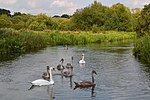Bourne Rivulet

The Bourne Rivulet is a river in the English county of Hampshire. It is a tributary of the River Test. The Bourne Rivulet (known as 'The Bourne' locally) is a winterbourne (a seasonal chalk stream that rises and falls with the water table). It usually rises in January and flows until around August each year. It normally runs from the village of Upton and flows through the villages of Hurstbourne Tarrant, St Mary Bourne and Hurstbourne Priors before joining with the Test near Tufton. Above Hurstbourne Tarrant it is known as the Swift or River Swift.Due to water extraction in the drainage basin, the upper flow is more intermittent than naturally. However Vitacress Salads Ltd.'s watercress plant, which is at the perennial headwater point, maintains flow through its pumping of extracted water not needed down into the stream.
Excerpt from the Wikipedia article Bourne Rivulet (License: CC BY-SA 3.0, Authors, Images).Bourne Rivulet
Paper Mill Bridge, Basingstoke and Deane
Geographical coordinates (GPS) Address Nearby Places Show on map
Geographical coordinates (GPS)
| Latitude | Longitude |
|---|---|
| N 51.21 ° | E -1.3605555555556 ° |
Address
Paper Mill Bridge
SP11 6QU Basingstoke and Deane
England, United Kingdom
Open on Google Maps







